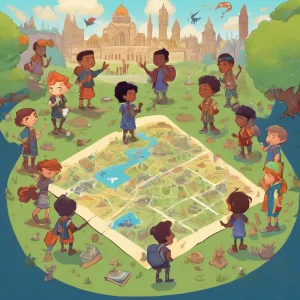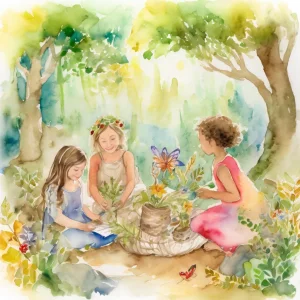Activity
Similar Activities
Enchanted Melodies: The Musician Money Mystery Game
Children’s Age: 9–12 years
Activity Duration: 10 minutes
An engaging activity where children learn about probability and famous musicians while earning money for clues in a mystery game.
Activity Duration: 10 minutes
Enchanted Savings: Holiday Savings Treasure Hunt Adventure
Children’s Age: 11–15 years
Activity Duration: 35 – 40 minutes
The "Holiday Savings Treasure Hunt" is a fun outdoor activity for kids aged 11 to 15, focusing on money use, saving, teamwork, and decision-making skills. Set up involves creating …
Activity Duration: 35 – 40 minutes
Nature-Inspired Drawing Activity
Children’s Age: 8–9 years
Activity Duration: 10 – 25 minutes
An outdoor activity where children draw natural elements to foster creativity and ecological awareness.
Activity Duration: 10 – 25 minutes
Shadow Hunt and Solar Exploration
Children’s Age: 5–6 years
Activity Duration: 10 – 30 minutes
An activity combining Physics, Space, and Ecological Awareness for children aged 5-6 to explore shadows and solar energy.
Activity Duration: 10 – 30 minutes
Nature Scavenger Hunt: Adventure in the Wild
Children’s Age: 4–9 years
Activity Duration: 10 minutes
An outdoor, nature-based activity promoting ecological awareness and cognitive development in children aged 4-9 years.
Activity Duration: 10 minutes
Cultural Collage Creations: Exploring World Wonders Together
Children’s Age: 7–9 years
Activity Duration: 10 – 25 minutes
Let's embark on a creative journey with "Cultural Collage Creations"! This educational craft project invites children to explore diverse cultures through art. Gather supplies and c…
Activity Duration: 10 – 25 minutes
The Global Treasure Hunt: Cultural Adventure Quest
Children’s Age: 9–11 years
Activity Duration: 10 – 30 minutes
Get ready for an exciting Global Treasure Hunt adventure! You'll explore different countries, solve clues, and work together in teams. All you need is a map, some clues, and a sens…
Activity Duration: 10 – 30 minutes
Space Adventure Obstacle Course: Galactic Learning Journey
Children’s Age: 6–12 years
Activity Duration: 25 minutes
Get ready for an awesome adventure with the Space Adventure Obstacle Course! You'll crawl through cardboard box spaceships, jump over paper tube asteroids, and follow colorful tape…
Activity Duration: 25 minutes
Cosmic Harmonies: Music from Space Journey
Children’s Age: 10–12 years
Activity Duration: 40 minutes
"Music from Space" is an engaging activity tailored for children aged 10-12, combining fun and education to promote academic growth, empathy, and ecological awareness. Participants…
Activity Duration: 40 minutes
Eco-Tech Dance Party: Nature's Rhythms and Tech
Children’s Age: 6–10 years
Activity Duration: 25 minutes
The "Eco-Tech Dance Party" activity merges technology, dance, and eco-awareness for an engaging experience. Ideal for children, this activity promotes moral growth, language develo…
Activity Duration: 25 minutes
Enchanted Forest Tales: Nature Play Theater
Children’s Age: 4–6 years
Activity Duration: 15 – 25 minutes
Engage children aged 48 to 72 months in the "Nature Play Theater" activity, fostering communication skills and ecological awareness. Set up an outdoor performance area with natural…
Activity Duration: 15 – 25 minutes
Eco-Friendly Nature Scavenger Hunt: Discover & Learn
Children’s Age: 11–15 years
Activity Duration: 30 – 40 minutes
Embark on the Eco-Friendly Nature Scavenger Hunt to engage children in nature exploration and ecological learning. This activity promotes communication skills and teamwork while fo…
Activity Duration: 30 – 40 minutes




























